Naked-Eye Comets in 2001
Comet Ikeya-Zhang (naked-eye comet in 2002)
Comet NEAT (potential bright comet in 2004)
Latest update on comets (December 2005)
Go to latest update (April 1, 2002)
One of the many recent comets discovered by the LINEAR program has become unexpectedly bright. Comet C/2001 A2, discovered on January 15, 2001, was never expected to become especially bright, however it now appears that its nucleus split in two around mid-March, at which time it started to become much brighter than had originally been expected. It continued to brighten from that point, and by the time it ceased to be visible from the northern hemisphere around the beginning of May it had already almost reached naked-eye visibility. Reports that have been received from the southern hemisphere since then indicate that the comet's brightness has continued to increase.
This particular comet LINEAR is at perihelion on May 24, 2001, at a distance of 0.78 AU from the sun. At the end of June it passes 0.24 AU from the earth, and if it maintains its current brightness trend it may be as bright as 4th magnitude around that time. By then it will again be visible from the northern hemisphere, located in the southeastern skies before dawn.
The below two images taken with the Southwest Institute's telescope/CCD system illustrate the comet's dramatic rise in brightness. The left image was taken on March 24 with the 30-cm telescope, the right on April 16 with the 20-cm telescope; both images are 30-second exposures. Observation reports from the southern hemisphere indicate that the comet has now developed a tail at least two degrees long.


UPDATE: Comet LINEAR continued to be a moderately bright naked-eye object from the southern hemisphere during June, becoming visible in the morning sky, and apparently undergoing another brightness increase (to 3rd magnitude) shortly before mid-June. The below photograph was taken by Alan Hale on the morning of June 16 from Harare, Zimbabwe.
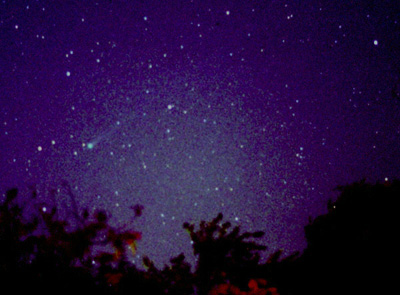
As was demonstrated by Comet C/2001 A2, the brightnesses of comets are notoriously difficult to predict. Initial prediction suggest that Comet C/2000 WM1 may be a moderately dim naked-eye object between 4th and 5th magnitude when nearest Earth, and possibly a magnitude brighter when near perihelion. At the time it is brightest the comet will only be visible from the southern hemisphere, but should remain accessible from the northern hemisphere until late December.
We expect to have a special page devoted to information and images of this comet as we get closer to its main appearance. Check back for more details as that time approaches.

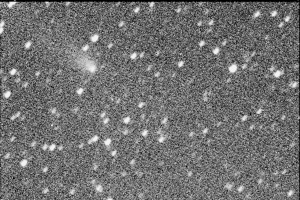
The comet is now approximately 11th magnitude, bright enough to be visible in moderate-sized backyard telescopes. It continues to brighten and develop nicely as it approaches perihelion, however it is still running a little over one magnitude fainter than the original predictions for this time. If this trend keeps up, the comet will be a dim naked-eye object of 5th or 6th magnitude when it is closest to the earth in December.
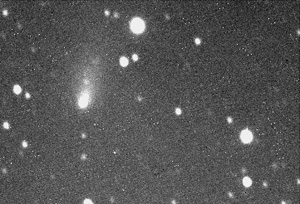
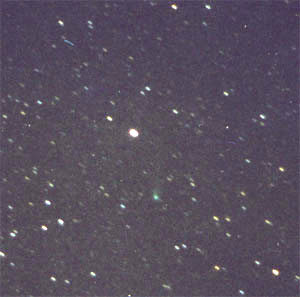
The comet faded as it receded from the earth, and was about magnitude 6 when it became invisible from the northern hemisphere during late December. During January it was only observable from the southern hemisphere, and it remained near 6th magnitude through perihelion passage on January 22. However, near the end of January it underwent an apparent outburst, for a brief time becoming as bright as 3rd magnitude, although at that time it was in conjunction with the sun and was difficult to observe.
Comet LINEAR had faded to 6th magnitude by the time it again became visible from the northern hemisphere, during the latter part of February. It has continued to fade since then, being almost 9th magnitude by the end of March. It will continue fading during the coming months as it exits the inner solar system.
The CCD image to the right was taken on the morning of March 15.
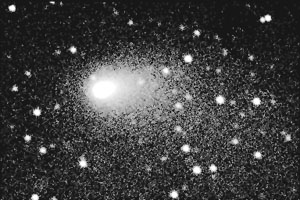
On February 1, 2002, a new comet was independently discovered by Kaoru Ikeya in Japan (discoverer of five comets during the 1960s, including the daylight comet Ikeya-Seki in 1965) and by Daqing Zhang in China. The comet was then 9th magnitude but has brightened dramatically since then as it has approached both the earth and the sun. Perihelion passage (0.51 AU from the sun) took place on March 18, and the comet will pass 0.40 AU from Earth on April 29.
The photograph to the right was taken on the evening of March 9, at which time Comet Ikeya-Zhang was 5th magnitude. By the end of March it had brightened further to 3rd magnitude, becoming the brightest comet to appear since Hale-Bopp five years ago. (Further photographs will be posted in the near future.)


The comet's past history of returns is still being sorted out. In addition to its probable identity with the comet of 1661, Comet Ikeya-Zhang has also been tentatively identified as possibly being identical to comets that were observed in A.D. 1273 and in A.D. 877.
Other than the fading Ikeya-Zhang, there are no bright comets presently visible, although numerous faint comets are being tracked at the Southwest Institute and elsewhere. (See the NEA images page for images of some of these objects.) The next expected bright comet is Comet NEAT C/2001 Q4, which should be bright during the early months of 2004 (see below); another bright comet could always appear at any time, however.
Calculations have now firmly established that Comet Ikeya-Zhang is indeed the same comet that was observed by Johannes Hevelius (among other astronomers of that era) in 1661. It has been assigned the periodic comet designation 153P, and the current orbital period is approximately 367 years; thus, our descendants should see this comet again sometime around the year 2370. It is also possible that comets observed in A.D. 1273 and A.D. 877 were earlier returns of Comet Ikeya-Zhang, but the available observations are such that we can't make any definitive statements about this one way or the other.
On August 24, 2001, the Near-Earth Asteroid Tracking (NEAT) program, which utilizes (among other telescopes) the 1.2-meter (48 inch) Schmidt telescope at Palomar Observatory in California, discovered a very faint comet which was subsequently found to be located beyond the orbit of Saturn. Recent orbital calculations indicate that this comet does not pass perihelion until May 15, 2004, when it will be located 0.96 AU from the sun. A week prior to that it will approach to within 0.33 AU of the earth.
At this time it is all but impossible to make any accurate predictions as to how bright Comet NEAT will become, but if it behaves in any way "normally" it has the potential to be a rather bright naked-eye object around the time it is nearest the sun and earth. This page will carry more information about the comet as it makes its way into the solar system.
The image at right is a two-minute exposure obtained on the morning of August 12, 2002. This was taken during the early stages of dawn, so it is a bit "noisy," but the comet nevertheless shows up moderately well.
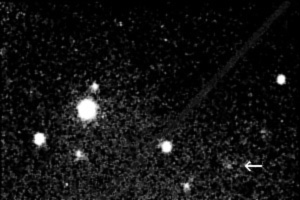
Meanwhile, another recently-discovered comet may also be quite bright during early 2004. This is Comet C/2002 T7, discovered by the LINEAR program on October 14, 2002, at which time it was a faint object of about 17th magnitude located 6.9 AU from the sun. It passes perihelion on April 23, 2004, when it will be 0.62 AU from the sun; it passes 0.26 AU from Earth four weeks later. Beginning in late May both it and Comet NEAT will be simultaneously visible in the evening sky, and both objects could be prominent naked-eye objects at that time. At this writing, meanwhile, Comet LINEAR is located in the constellation Taurus (in the evening sky) some ten degrees north of the Hyades star cluster, and is approximately 15th magnitude, too faint for visual observations. These may become possible around August when the comet emerges into the morning sky at about 13th magnitude.
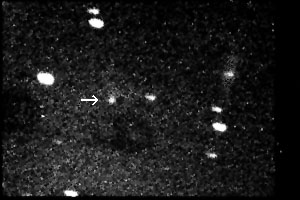
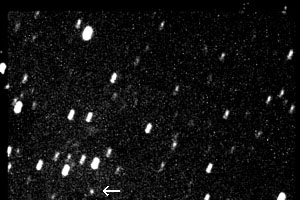
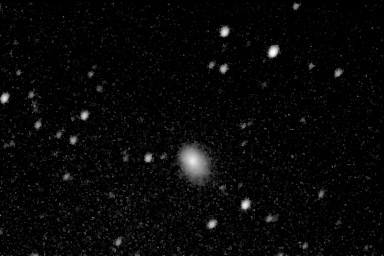
Neither Comet NEAT nor Comet LINEAR lived up to their expectations. Comet LINEAR never became brighter than 4th magnitude as observed from the northern hemisphere, and even when brightest was fairly close to the horizon and not especially easy to observe. Comet NEAT, meanwhile, reached 3rd magnitude during May 2004, but although easily visible to the unaided eye it did not develop a bright or conspicuous tail.
By a remarkable coincidence, the above two comets were joined by a third relatively bright comet, Comet Bradfield C/2004 F4, which had been discovered by Australian amateur astronomer William Bradfield in March 2004. When Comet Bradfield became visible in the northern hemisphere's morning sky in late April it was about 4th magnitude and was exhibiting a long and moderately conspicuous tail. The show was brief, however, with the comet's fading below naked-eye visibility by mid-May.
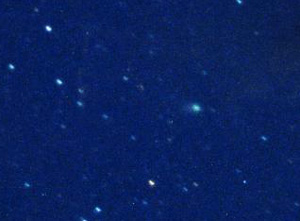
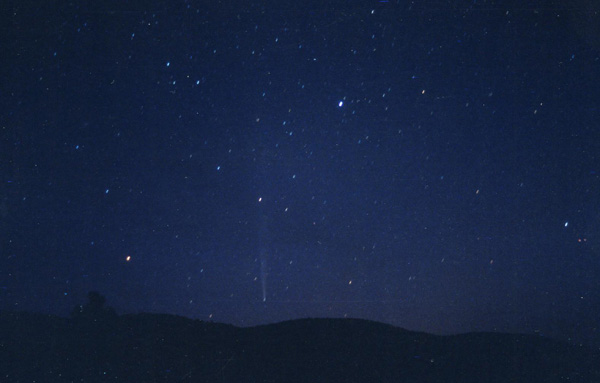
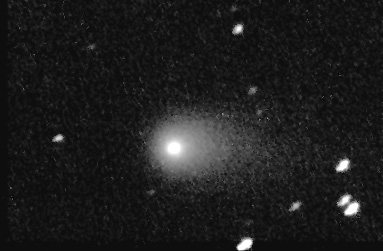
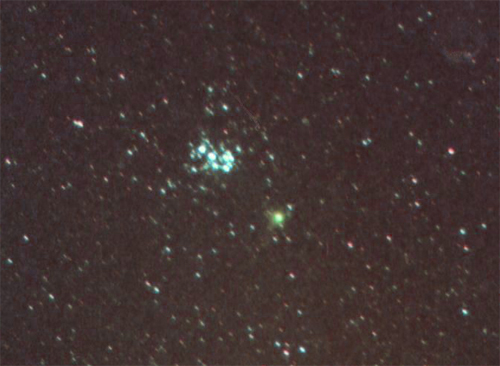
Back to main page